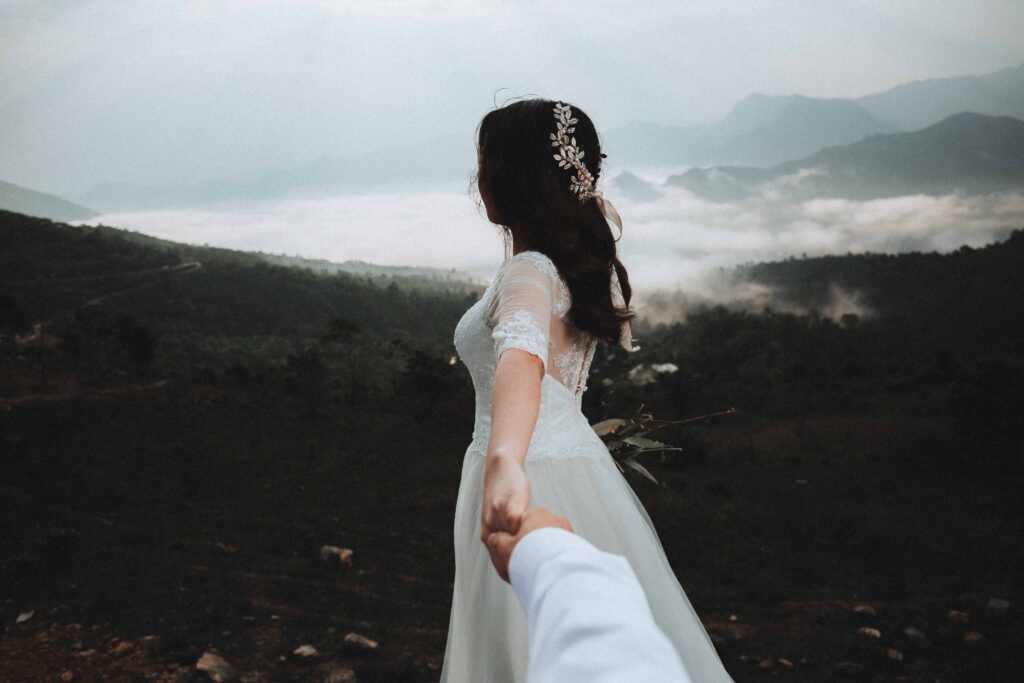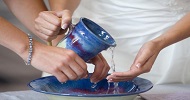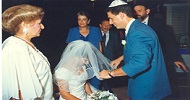This ceremony takes place immediately after the signing of the ketubah and wedding license, and helps the couple, and their close family, to refocus upon the meaning of the moments they are about to live.
This setup assumes a heterosexual marriage but it can certainly be adapted. The bride and groom stand back to back, with their parents facing them on either side (and/or appropriate family members). First the bride’s family blesses her with the blessing of Rivka, and then the groom’s family blesses him. They then continue with the y’simkha, and then we go back to the bride for her y’simekh.
The form of the final blessing is Marcia Falk’s, from her Book of Blessings.
Bride’s parents/ family:
אֲחוֹתֵינוּ אַת הֱיִי לְאַלְפֵי רְבָבָה
A’khoteynu at hey’yi l’alfey r’vavah.
Our sister, may you grow into myriads of thousands!
Groom’s parents/family:
אָחִינוּ אַתָּה הֱיֵה לְאַלְפֵי רְבָבָה
Akhinu atah hey’yey l’alfey e’vavah.
Our brother, may you grow into myriads of thousands!
יְשִׂימְךָ כְּאֶפְרַיִם וּמְנַשֶּׁה
Y’shimkha k’efraim oom’nashe.
May God make you like Efrayim and Menashe—these two sons of Joseph, the first Jews to be born and raised in exile, yet found their place with their brothers as builders of the House of Israel. Wherever you wander, may you find your strength in the journey you share with the people of Israel.
Bride’s parents/family:
יְשִׂימֵךְ כְּרָחֵל לֵאָה וּמִרְיָם
Y’simekh k’rakhel leah oo’miryam.
May God make you like Rahel, Leah, and Miriam. May you be like these sisters, mothers, and companions who brought light to the tent, brought us to a fuller envisioning of the many manifestations of God’s presence in our midst, and taught us to dance.
The two families are now invited to share a few moments speaking privately and quietly with their offspring/family member who is about to get married. When they are finished, the bride and groom turn to face each other, and are invited to take each other’s hands. The rabbi points out that this is the moment when the parents literally send their children forth from their family of origin so that they make make their own family. All they have tried to teach and all their love goes with these adult children who will soon commit their lives to each other beneath the huppah.
Rabbi concludes:
When you next behold each other’s faces, it will be beneath the huppah, the symbol of the home you now begin to build. In that creative act of love may you always build each other, and yourselves, and may you always see each other’s faces the reflection of God’s presence.
[If there is a veil, it is lowered now.]
Rabbi concludes with final blessing:
תִּהְיוּ אֲשֶׁר תִּהְיוּ וְתִהְיוּ בְּרוּכִים בְּכָל אֲשֶׁר תִּהְיוּ
Ti’h’yu asher ti’h’yu v’ti’h’yu b’rukhim b’khol asher ti’h’yu.
Be who you are, and may you be blessed in all that you will be.
[Procession to huppah immediately follows]












